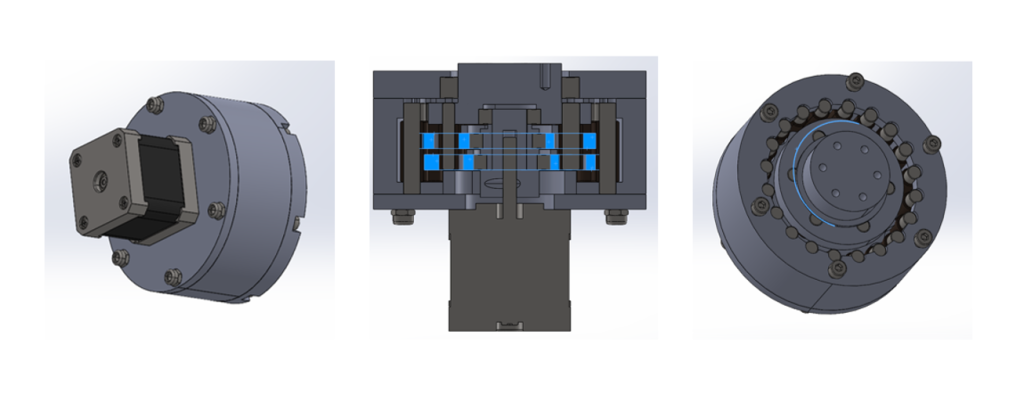Unique Registration Number: GSInC-I-000324
Innovator Name:
- Sarthak Naik
- Tejas Shirodkar
- Shubang Adpaikar
- Kenworth Domingos Xavier Fernandes
- Parth Ramprakash Maurya
Name of a Mentor:- Dr. Pravin Verekar
Name of School/College/Startup/Organisation: Don Bosco College Of Engineering
Contact No: +918421105176
Contact Email: project.dbce@gmail.com
Project Objective:
- High Torque Transmission: Designed for applications where compactness is essential,
this system effectively transmits high torque levels while minimising size and weight. - Precise and Smooth Motion: Ensure accurate positioning and smooth operation by
achieving precise motion control with little vibration and backlash. - Durability and Reliability: Develop durable components that can withstand substantial
loads and challenging operating environments, ensuring prolonged reliability and
minimal maintenance requirements. - Compact Design: Optimize the gearbox design to fit into confined spaces within
machinery or systems, maximizing efficiency and minimizing footprint. - Noise and Vibration Reduction: Minimize noise emissions and vibrations during
operation, enhancing user comfort and reducing wear on components. - Customizability: Allow for customisation of the gearbox to meet specific application and performance needs by providing freedom in design factors including gear ratios, sizes, and materials.
- Compliance and Standards: Meet industry standards and regulatory requirements for safety, performance, and environmental impact, ensuring the gearbox is suitable for its intended application
Abstract:
- The cycloidal gear drive, renowned for its unique cycloid profile, stands out due to its exceptional efficiency, compact design, and high torque transmission capabilities. This project aims to design and develop a cycloidal gear drive, targeting optimization for various industrial applications. The main goals include enhancing load distribution, minimizing backlash, increasing durability, and improving overall mechanical efficiency. The design phase commenced with a comprehensive analysis of cycloidal gear geometry, focusing on the mathematical principles governing its motion. Solidworks software was employed to create precise models of the gear profiles, ensuring accurate representation of the cycloid curves. Finite Element Analysis (FEA) was done on the models to check their performance under varying load conditions and to pinpoint potential stress areas. Material selection and manufacturing processes played an important role in the development phase. Stainless steel (SS304) was chosen for their durability, and advanced precision machining techniques were employed to achieve the necessary accuracy. Prototypes were fabricated using 3D printing filaments, such as PLA and ABS, and tested to evaluate torque capacity and load. The data obtained from the testing phase helped in design improvements. The refined cycloidal gear drive exhibited numerous improvements over conventional gear systems. It demonstrated significantly reduced backlash, higher torque density, higher load distribution, and enhanced mechanical efficiency. Validation through testing confirmed its robustness and suitability for high-performance applications in fields such as robotics, aerospace, and industrial automation. In conclusion, this project successfully culminated in the development of a high-performance cycloidal gear drive. The fusion of innovative design, material selection, and advanced manufacturing techniques resulted in a product that meets the demanding requirements of modern mechanical systems.
Project Outcome/result/findings:
Efficiency =ExperimentalGR/ActualGR
=[16.98/19]×100
= 89.38%
- Load vs steps relationship at 1000 set speed depicts that increasing the number of steps
from 200 to 6400 in a cycloidal drive at a constant speed of 1000 units enhances load
capacity non-linearly, crucial for optimizing performance in high-precision applications. - Load vs steps relationship at 10000 set speed indicates that the load capacity of the
cycloidal drive increases progressively with step increments, demonstrating efficient
performance and robust load handling at a constant speed of 10,000 RPM. - Torque vs Load graph at 1000 set speed demonstrates that the cycloidal drive effectively
increases torque output proportionally with load, highlighting its efficiency and suitability
for applications requiring precise torque control under varying load conditions at a set
speed of 1000 RPM. - Torque vs Load graph at 10000 set speed demonstrates that the cycloidal drive effectively
increases torque with load, showing robust performance and efficiency at a high set speed
of 10,000 RPM.
Innovative Approach:
- Design Phase: Using parametric equation function in SolidWorks designed a cycloidal gear of suitable size.
- Material Selection: Choose lightweight, high-strength materials for critical components.
- Manufacturing: Use additive manufacturing to produce complex components with high precision. Employ CNC machining for critical parts that require tight tolerances.
- Assembly: Use precision jigs and fixtures to ensure perfect alignment of components.
- Testing and Optimization: Test the assembled gearbox under load conditions to identify any issues.








